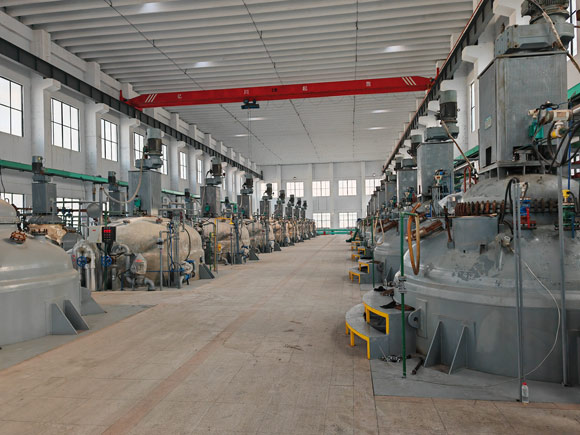Polyvinyl chloride (PVC) arises from the combination of vinyl chloride monomer (VCM) in the presence of peroxides, azo compounds or by the free radical polymerization method when exposed to heat or light. When spoken of together, vinyl chloride homopolymers and vinyl chloride copolymers are known as polyvinyl chloride resin.
Ⅱ.Production Method
First, we use the Suspension Polymerization method.
With the suspension polymerization method, the monomers become suspended and divided into small droplets. An appropriate oil-soluble initiator is first dissolved in the monomer. The droplets are used for carrying out the polymerization reaction. Within a while, the heat of the polymerization is soaked up by the water. If you want these droplets to form as beads when added into the water, you must add a suspension stabilizer such as gelatin, polyvinyl alcohol, methyl cellulose, hydroxyethyl cellulose or others. The most commonly used initiators are organic peroxides and azo groups, for example, diethylhexyl peroxydicarbonate, azobisisoheptonitrile and azobisisobutyronitrile. The large-scale polymerization takes place in a polymerization kettle fitted with an agitator. When polymerization is done, the material goes to a monomer recovery tank or to a stripping tower to retrieve the monomer. Then it enters a mixing kettle, is washed, treated in a centrifuge, dehydrated and dried to produce the final resin.
2) Emulsion Polymerization Method
Industries have been making PVC using emulsion polymerization for a long time. As well as water and vinyl chloride monomer, sodium alkyl sulfonate is added as an emulsifier to help disperse the monomers in water in emulsion polymerization. For this purpose, water-soluble potassium persulfate or ammonium persulfate is used as an initiator. Another method used is the oxidation-reduction initiation system. There is a difference between polymerization and the suspension method. In addition, polyvinyl alcohol helps to stabilize the mixture, dodecyl mercaptan helps keep the mixture regulated and sodium bicarbonate acts as a buffer. Three techniques are used for polymerization: intermittent, semi-continuous and continuous. The latex-like polymerization product has emulsion particles with a size of 0.05 to 2μm and is either used directly or converted into a powder by spray drying. Controlling the emulsion polymerization cycle is easy because the process takes less time. As a result, the resin has a high molecular mass and a consistent distribution of polymer size. PVC flour is often used to make polyvinyl chloride paste, artificial leather and impregnated products.
3)Bulk Polymerization Method
The polymerization device of bulk polymerization method is special, mainly composed of a vertical prepolymerization kettle and a horizontal polymerization kettle with a frame stirrer. The polymerization is carried out in two stages. The monomer and initiator are first prepolymerized in the prepolymerization kettle for 1 hour to generate seed particles. The conversion rate reaches 8% to 10%, and then flow into the second stage polymerization kettle, and the same amount of monomer as the prepolymer is added to continue polymerization. When the conversion rate reaches 85% to 90%, the residual monomer is discharged, and then the finished product is obtained by crushing and sieving. The particle size and shape of the resin are controlled by the stirring speed, and the reaction heat is taken out by the reflux condensation of the monomer. This method has the simple production process, good product quality, and low production cost.

Ⅲ.Usage
Polyvinyl chloride is broadly used as a common plastic in many applications. PVC resists water leaks and is flame retardant. Many places use polyvinyl chloride for water supply pipes, household pipes, home wallboard, machine housings in businesses, electronic product packaging, medical equipment, food packaging and other areas.
IV. Summary
Polyvinyl chloride was once the world’s largest-volume general-purpose plastic with a wide range of applications. Based on existing technologies, Tianli will increase its R and D investment in polyvinyl chloride production, continuously innovates processes, and improves the efficiency, energy saving and stability of production equipment to meet the needs of high-quality processes in the polyvinyl chloride industry.

 EN
EN
 AR
AR
 BG
BG
 HR
HR
 CS
CS
 DA
DA
 NL
NL
 FI
FI
 FR
FR
 DE
DE
 EL
EL
 HI
HI
 IT
IT
 JA
JA
 KO
KO
 NO
NO
 PL
PL
 PT
PT
 RO
RO
 RU
RU
 ES
ES
 SV
SV
 TL
TL
 IW
IW
 ID
ID
 SR
SR
 UK
UK
 VI
VI
 TH
TH
 TR
TR
 FA
FA
 AF
AF
 MS
MS
 UR
UR
 BN
BN
 LO
LO
 LA
LA
 MY
MY
 KK
KK
 UZ
UZ